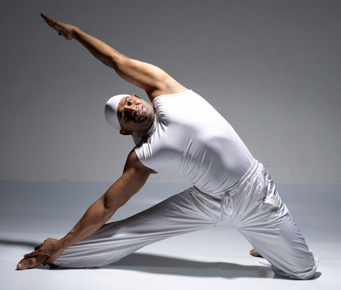The most important benefit of yoga is physical and mental therapy. According to medical scientists, yoga therapy is successful because of the balance created in the nervous and endocrine system. Through the practice of yoga, we become aware of the interconnectedness between our emotional, mental and physical levels.
This month, we continue to explore a few poses and the therapeutic benefits.
 Open Hips, Inner Thighs and Relieve Stiff Lower Back Baddha Konasana (Butterfly Pose)
Open Hips, Inner Thighs and Relieve Stiff Lower Back Baddha Konasana (Butterfly Pose)
1. Sit upright with legs stretched out in front.
2. Next, bend the knees and place the soles of the feet together.
3. Grasp onto the feet and interlace the fingers together.
4. Inhale, lengthen the spine.
5. Exhale, bend forward and move down as low as possible while keeping the spine straight. This is one set. Practise 10 sets and hold and breathe in the final position for about 10 long and slow breaths.
Benefits: This gives a wonderful stretch to the inner thighs, groin and opens tight hips.
It reduces stiffness in the hip flexors and increases blood circulation to the pelvic region,
keeping the reproductive organs healthy. It is also good hinchables for women that helps normalise the menstrual cycle and helps relive pains and cramps.
 Supta Baddha Konasana (Sleeping Butterfly)
Supta Baddha Konasana (Sleeping Butterfly)
1. From the Butterfly Pose, gently lean back to lie down on the back.
2. Place the arms a few inches away from the body with the fingers curled naturally and palms facing up.
3. Tuck the chin close to the chest and distribute the weight equally on both sides. Close the eyes.
4. In this position, relax all the muscles completely and be very still.
5. Drop the shoulders and the full weight of the body to the floor. Relax all the facial muscles. Allow the body to sink deeper into the floor and become aware of the breathing in the nostrils.
6. With each exhalation, relax the body further and become as relaxed as possible.
7. Lie in this position for as long as desired.
8. To release, turn to any one side and gently sit up.
Benefits: This is a very relaxing position that helps to reenergise and balance both sides of the body. In addition, it also reduces stiffness in the hip joints and opens up tight hips.
 For a Trim Waist and Supple Spine
For a Trim Waist and Supple Spine
Saithalyasana (Animal Relaxation Pose)
1. Sit upright with legs stretched out in front.
2. Bend the right knee and place the sole of the right foot against the right buttock.
3. Bend the left knee and place the left heel close to the perineum.
4. Turn the torso to face the left knee.
5. Inhale, raise the arms up and lengthen the spine.
6. Exhale, bend forward as much as possible and bring the forehead towards the floor.
7. Relax in this position and take 5 long and deep breaths.
8. To release, inhale and return to the starting position.
9. Repeat the other side. This is one set.
Practise 2 – 3 sets.
Benefits: Saithalyasana increases flexibility pula pula inflavel in the hip joints, tones and massages the internal organs and trims the waist. At the same time, it stretches the back and keeps the spine supple.
1. To begin, come on the knees.
2. Straighten the right leg and place the right foot flat onto the floor.
3. Inhale, raise the left arm up and lengthen the spine.
4. Exhale, slide the torso to the right while keeping the hip forward and lean back slightly.
5. Slide as far right as possible and keep the left bicep close to your left ear.
6. Gaze towards the ceiling and enjoy the stretch in the left oblique.
7. Stay in this position for 5 long and deep breaths.
8. To release, inhale and return to the starting position.
9. Repeat with the left side. This is one set.
Practise 2 – 3 sets.
Benefits: The Gate Pose tones the waist and reduces excess fat from the waistline. At the same time, it stretches the internal organs and keeps the spine supple.



















 Other
Other